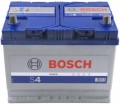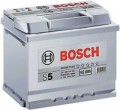Standard
The form factor describes the general design features of the battery, primarily the way the terminals are installed and their dimensions, as well as the dimensions of the battery itself.
—
European. A distinctive feature of European batteries are the terminals, somewhat recessed into the case. Due to this, this form factor is considered safer than the Asian form factor — the risk of a short circuit is lower when the battery falls on a conductive surface or when a metal object hits it. In addition, the terminals themselves are usually made in the form of Euro cones (see below for more details). As for the dimensions, European batteries have more depth and less height than Asian ones. As the name implies, this form factor is found in cars of European manufacturers, mainly passenger cars.
—
Asian. Asian batteries are easy to identify by the terminals protruding from the top of the case; also, these terminals can be noticeably thinner than European ones, because. many models use JAP cones (although not all). If compared in size, then the "Asians" are taller and thinner than the "Europeans" (more precisely, they have less depth). This option is popular with Japanese and Korean automakers, and is also quite widespread among trucks.
— American. A rather rare form factor on our roads — due to the fact that cars from American manufacturers are most often delivered to us in the form
...of modifications adapted to Europe or Asia; original versions are rare. Lightweight batteries of this form factor have "USA" screw terminals (see "Terminals"), located not on the cover, but on the front wall of the case. At the same time, both “purely American” and combined batteries are produced, which, in addition to a pair of USA terminals on the front wall, also have contacts on the cover that are more familiar to east european drivers. And in cargo batteries of this form factor, the terminals are usually installed on the cover, in the left side location.
When choosing a battery, it makes sense to clarify which form factor is optimal for your car: a discrepancy in this parameter can cause compatibility problems up to the complete impossibility of installing a battery.Battery capacity
The electrical capacity of a battery, in other words, the amount of energy stored by a battery when fully charged. The capacity value is expressed in amp-hours and indicates the number of hours during which a fully charged battery will be discharged to the minimum allowable charge, delivering a current of 1 ampere to the load. For example, a capacity of 40 Ah means that the battery is capable of delivering a current of 1 A for 40 hours, or 2 A for 20 hours, etc. In fact, a more capacious battery gives more attempts to start the engine, and is also able to work longer at a low load (for example, when powering a car audio system).
The capacity requirements for different transport types differ markedly. So, in motorcycle batteries, it rarely exceeds 20 Ah, the average value for passenger cars is 40-80 Ah (but there are options for 100 Ah or more), and for heavy equipment like buses, an acceptable capacity starts somewhere from 100 Ah. The optimal value of the battery capacity is often indicated by the manufacturer in the characteristics of the vehicle, and when choosing a model by capacity, you should focus primarily on these figures.
Starting power (EN)
The starting power of the battery, measured according to the EN standard (the unified standard of the European Union). According to this standard, the starting power is the maximum power that the battery can deliver for 30 seconds at an electrolyte temperature of -18 °C without the voltage dropping below a certain level (for standard 12 V batteries - not lower than 7.2 V). The term "starting" appeared because this operating mode is similar to starting an engine, when the battery has to deliver a high-power power to the starter for a short time.
The recommended starting power value is generally related to the weight category of the vehicle: the heavier it is, the more powerful the power usually needed to start it. And many manufacturers directly indicate the recommended values in the characteristics of a particular vehicle model. If the battery is purchased as a replacement, the general rule is: its starting power should be no less than that of its predecessor.
Note that in practice, starting power designations may be encountered according to 3 more standards: SAE (USA), DIN (Germany) and TU (GOST 959-91). The first is almost identical to EN, and DIN and TU are quite easy to translate into EN and vice versa: they are similar to each other, and each of them gives a number approximately 1.7 times smaller than NE. That is, for example, to replace a 200 A battery according to TU, you should look for a model with a power of at least 340 A (200 * 1.7) according to EN.

